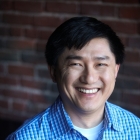A story in the San Francisco Chronicle points out the obvious but backs it up with numbers and anecdotes: There aren't many Asian Americans playing collegiate sports. Harvard basketball player Jeremy Lin says in the story, "It's a sport for white and black people. You don't get respect for being an Asian American basketball player in the US."
Lin, a 6-foot-3 point guard, took his Palo Alto, CA, high school team to a state championship, but didn't get any scholarship offers from big schools. He says in the story that his ethnicity "did affect the way coaches recruited me. I think if I were a different race, I would have been treated differently."
The story focuses on men's basketball and has several players and coaches citing stereotyping and race as factors in keeping the numbers down. Of the 4,814 players in men's Division I (the biggest schools) basketball during the 2006-07 season, 19 were Asian American (0.4 percent). Combine Division I, Division II and Division III, and the percentage rises to 0.7.
The statistics are from the NCAA Student-Athlete Race and Ethnicity Report and the numbers are pretty low for other sports -- men and women. The report writers seem to see the skewed numbers, too, and mostly wrote about black and white athletes, except for in charts breaking down the data.
If there's any bright side, the numbers are up. In 1999-00, 1.2 percent of NCAA athletes were Asian American males and 1.5 percent were Asian American females. In 2006-07, the numbers were 1.5 percent for men and 2.1 percent for women. The only group with lower numbers were American Indian/Alaskan Native, who were at 0.3 percent for males and 0.4 percent for females in 2006-07.
The highlights of the 2006-07 data in the report:
- Women's basketball, the biggest female sport, had 1.1 percent Asian Americans.
- Badminton had the highest percentage of Asian Americans, with 34 percent women. Men were listed at 0.0, and from what I could find, it seems badminton has few or no men's teams and just a handful of women's teams.
- Fencing was the next highest percentage of Asian American participation, 14.1 percent female, 10.8 percent male.
- Football, up there with men's basketball as a big-money sport, had 1 percent Asian American participation.
Too bad there's no ping pong! (Just kidding. Sorry, bad joke).
Seriously, the story quotes Asian American studies Professor Henry Yu saying family pressures are one factor keeping young Asian Americans from participating in sports. Parents want their kids to focus on school and work.
I just remember my parents never understanding why I wanted to play sports. The pressure from them led to me to quit football before the season started my freshman year of high school. Football would keep me from working, and I might get crushed (in hindsight, this is probably true). I did run track through high school, though my parents never seemed interested and never came to watch me run.
In any event, there are a lot of factors involved in this issue. Any budding athletes or former budding athletes out there share similar experiences as Lin or me?










Comments